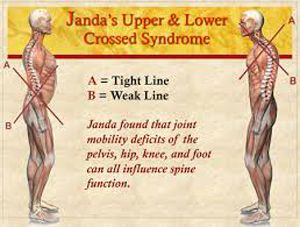Lift with your legs not your back! This is something that has been taught to first responders as a method to reduce the rate and severity of injury when lifting patients and equipment.
But what if lifting with your legs is a total fallacy?
As responders in today’s increasingly sedentary society, we are set up to fail. We are set up to fail for a few simple and predictable reasons.
First, we sit way too much. Second, we are full of muscle imbalances. And third, as a profession we have never accepted that our job is physical and one of the few things that can reduce our chance of injury is being fit.
On top off all that, we can add chronic fatigue, stress, inflammatory foods and dehydration as further stacking the deck against us and setting us up for injury.
Lower crossed syndrome
Thanks to the research of Vladimier Jandae, we have know since the 1940s that a syndrome of muscle imbalances in the hips and pelvis, lower crossed syndrome, causes the muscles that should protect our back and knees to function improperly.
Over time, because we sit too much and because we have done improper exercises like crunches and leg raises, our hip flexors become tight. As they become tight, they pull the pelvis forward and as the pelvis is pulled forward some interesting things happen.
The abdominal wall lengthens; this is bad. We have all been taught that strong abs equals a strong back, but long muscles, the abs in this case, do not fire well or at all.
For example, when you lean over a bed to transfer a patient to your cot, instead of your abs firing to support the back they are silent. This means that you have to buy the stability the abs should have provided from another muscle group, your back.
As the pelvis is pulled forward and your center of gravity shifts away from neutral, your body naturally wants to fix the problem. Your hamstrings (a hip extensor) wake up and begin to get tighter, essentially trying to pull the pelvis back into place.
Tug of war
There is a reason why most people with back pain have tight hamstrings, yet the hamstring tightness in almost all cases is a symptom not the cause of the problem.
As the hip flexor pulls forward and the hamstrings pull back, a tug of war ensues that is exacerbated by firefighting and EMT activities. The most powerful muscle group in your body — the muscle group that is supposed to protect your back, the muscle group where all your lifting power comes from — is so confused that it does not do its job.
The term in the literature is “gluteal amnesia.” That’s right, your butt forgot what to do. In most cases of low back pain and injury, it’s the imbalance in the glutes that causes you to use your back to lift and not your legs.
If you came to me in the physical therapy clinic with LBP one of the first things I would do is get both your glutes to fire properly and together. Just doing this would reduce the pain and improve mobility in almost all our patients.
Without the ability to fire your glutes on any lift or transfer, you are essentially placing the load on your back.
A final issue we see is tightness in the calves and ankles. Tight boots, hard floors and sitting will all make your calves and ankles tight. When mobility is restricted here, you lose the ability to squat properly.
Holistic solution
So when you have to squat, your heels will raise off the floor. This further forces you to use your back to lift as your glutes cannot fire well when the heels are up. In fact, this also increases the risk of injury from walking, climbing stairs and stepping in and out of the truck — now you know why so many people get hurt just getting out of the truck.
 Lifting with your legs is what should happen naturally, provided that your body is free of a lower crossed syndrome.
Lifting with your legs is what should happen naturally, provided that your body is free of a lower crossed syndrome.
It always baffles me that in public safety, as a culture, we are so against pre-shift stretching and simple mobility tools like foam rollers that we know will reduce pain, lower risk of injury and help providers to move better. Why is investing in yourself and your own wellness such a hard sell?
Personally, I will never tell someone to lift with their legs because after almost 18 years of rehab experience and teaching over 200 EMS/fire ergonomics classes a year for the last eight years, I know that very few possess the physical ability to do it.
As a profession and as providers, we need to realize that the solution to reducing injury, improving wellness and career longevity will take a holistic approach that begins with synergy between employer and employee starting at the hiring process. Invest in yourself, invest in your employees and adopt simple strategies that will impact the bottom line for all of us.
And please, stop telling people to lift with their legs until they can actually do it.












